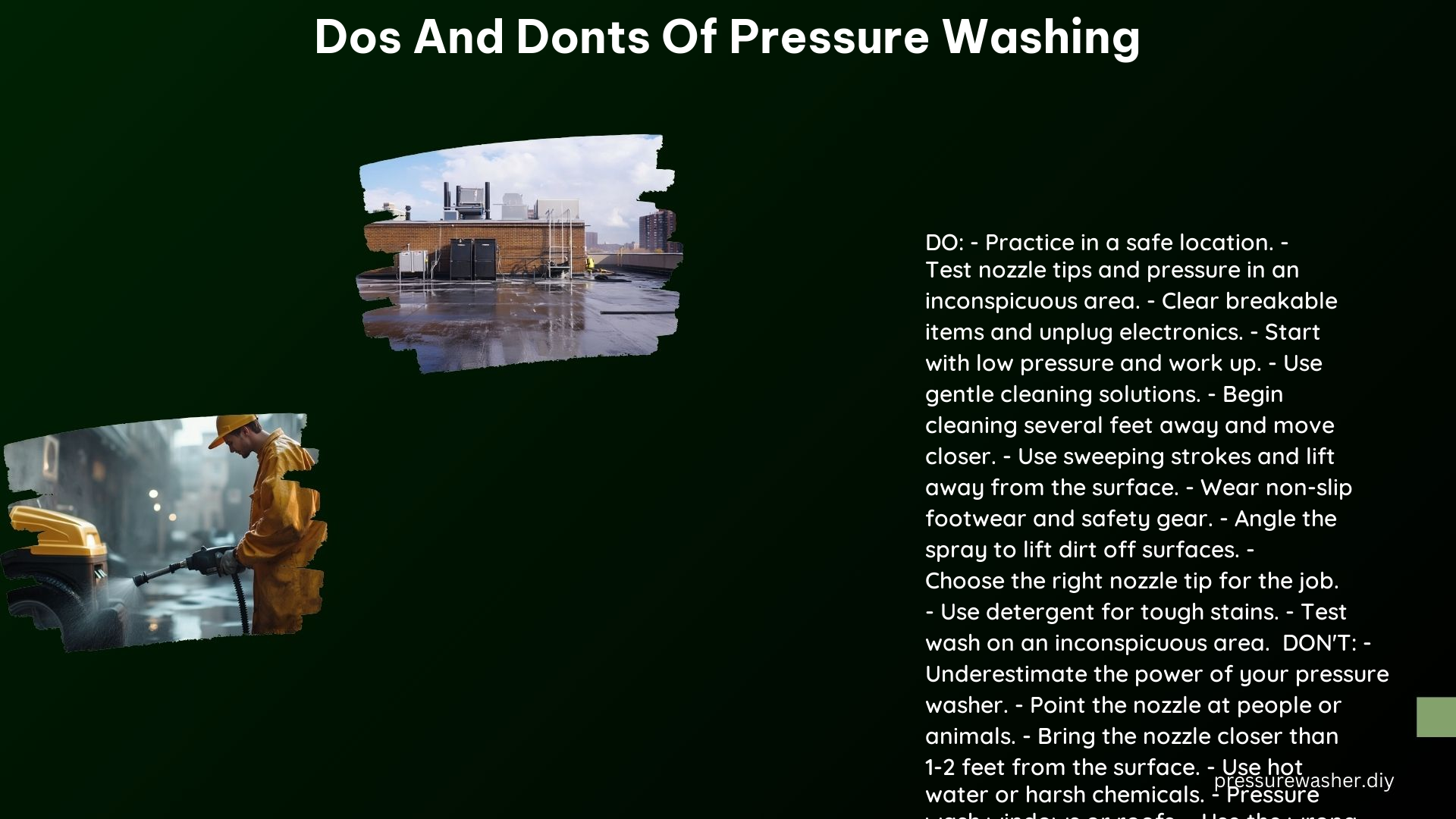Pressure washing is a powerful tool for cleaning and maintaining the exterior of your home, but it requires careful attention to detail to ensure safe and effective results. This comprehensive guide will walk you through the essential dos and don’ts of pressure washing, providing you with the technical specifications and expert insights to tackle your next project with confidence.
Dos of Pressure Washing
1. Start on a Low Pressure Setting
When it comes to pressure washing, it’s crucial to start with a low pressure setting and gradually increase as needed. Residential pressure washers typically operate between 1,000 and 2,900 PSI (Pounds per Square Inch), while professional-grade equipment can reach up to 6,900 PSI. Beginning with a lower setting allows you to assess the surface and adjust the pressure accordingly, preventing potential damage.
2. Keep the Nozzle in Motion
Maintaining a constant, sweeping motion with the pressure washer nozzle is essential for even distribution of water pressure and preventing damage to the surface. The angle of the nozzle should be kept at approximately 30-45 degrees, with a distance of at least 2 feet from the surface being cleaned.
3. Test the Nozzle on an Inconspicuous Area
Before tackling the main cleaning area, it’s crucial to test the pressure washer nozzle on an inconspicuous section of the surface. This allows you to ensure the nozzle tip is appropriate for the material and that the pressure setting is not too high, which could lead to damage.
4. Use Mild Cleaning Solutions
When it comes to pressure washing, it’s best to opt for mild, biodegradable cleaning solutions. Harsh chemicals can not only damage the surface being cleaned but also pose a risk to surrounding landscaping and the environment. Look for cleaning agents specifically formulated for pressure washing applications.
5. Clear the Area and Wear Protective Gear
Before starting your pressure washing project, take the time to clear the area of any breakable items, such as outdoor furniture or decorations. Additionally, it’s essential to wear appropriate safety gear, including safety glasses, gloves, and non-slip footwear, to protect yourself from the powerful water spray.
6. Select the Right Nozzle Tip
Pressure washer nozzle tips come in a range of angles, from 0 degrees (the most concentrated and powerful) to 40 degrees (the most gentle). Choosing the appropriate nozzle tip for the surface and cleaning task at hand is crucial to avoid damage. As a general guideline, use a 40-degree nozzle for delicate surfaces, a 25-degree nozzle for general cleaning, and a 0-degree nozzle for tough stains or heavily soiled areas.
7. Practice in a Safe Location
Before tackling your home’s exterior, it’s a good idea to practice using the pressure washer in a safe, open area, such as a driveway or a secluded section of your yard. This will help you get accustomed to the equipment’s handling and power, allowing you to develop the necessary skills and confidence.
8. Consider Professional Assistance
If you’re unsure about your ability to safely and effectively pressure wash your home’s exterior, it’s always a good idea to consider hiring a professional pressure washing service. They have the experience, equipment, and expertise to get the job done right without risking damage to your property.
Don’ts of Pressure Washing

1. Don’t Increase Pressure While in Motion
Avoid the temptation to increase the pressure while the pressure washer is in motion, as this can lead to a loss of control and potential damage to the surface. Instead, make adjustments to the pressure setting while the nozzle is stationary.
2. Don’t Use High-Temperature Water
Pressure washers are designed to use cold water, as high-temperature water is not necessary and can actually cause damage to some surfaces, such as siding or painted areas.
3. Don’t Use the Wrong Nozzle Tip
Selecting the appropriate nozzle tip for the job is crucial. Using the wrong nozzle, such as a 0-degree tip on a delicate surface, can result in significant damage. Always refer to the manufacturer’s recommendations or consult a professional to ensure you’re using the correct nozzle.
4. Don’t Spray Upward Against Siding
When pressure washing siding, it’s essential to avoid spraying the water upward, as this can force water into the gaps and crevices, potentially leading to water damage and mold growth.
5. Don’t Use Excess Cleaning Products
While it’s important to use a mild cleaning solution, applying too much can be just as detrimental as using harsh chemicals. Follow the manufacturer’s instructions for the appropriate dilution and application rates to avoid over-application and potential damage.
6. Don’t Angle the Spray Too Much
Angling the pressure washer spray too much, even with the appropriate nozzle tip, can decrease the overall pressure applied to the surface, reducing the cleaning effectiveness.
7. Don’t Pressure Wash Windows
Pressure washing windows is generally not recommended, as the high-pressure water can damage the seals and weaken the glass over time. Instead, consider using a soft-bristle brush and a mild cleaning solution for window cleaning.
8. Don’t Use Harsh Chemicals
Harsh chemicals, such as bleach or acidic cleaners, can cause significant damage to surfaces, landscaping, and the environment. Stick to mild, biodegradable cleaning solutions specifically designed for pressure washing applications.
9. Don’t Underestimate the Power
Pressure washers are powerful tools that can cause serious injury if not used with caution. Always be aware of the equipment’s capabilities and take necessary precautions to avoid accidents or damage.
10. Don’t DIY Without Experience
If you’re new to pressure washing or unsure about your ability to tackle a project safely and effectively, it’s best to consider hiring a professional pressure washing service. They have the training, equipment, and expertise to get the job done right without risking damage to your property.
Technical Specifications
- Pressure Settings: Residential pressure washers typically operate between 1,000 and 2,900 PSI, while professional-grade equipment can reach up to 6,900 PSI.
- Nozzle Tips: Pressure washer nozzle tips range from 0 to 40 degrees, with 0-degree nozzles providing the highest pressure and 40-degree nozzles providing the most gentle spray.
References
- RH Power Washing. (n.d.). The Dos And Don’ts Of Power Washing. Retrieved from https://www.rhpowerwashing.ie/the-dos-and-donts-of-power-washing/
- Family Handyman. (2024). 6 Common Mistakes Made When Pressure Washing. Retrieved from https://www.familyhandyman.com/article/pressure-washing-mistakes/
- First Coast Home Pros. (2017). Dos and Don’ts of Pressure Washing. Retrieved from https://info.firstcoasthomepros.com/blog/dos-and-donts-of-pressure-washing
- A Brilliant Solution. (2022). Pressure Washing Secrets Dos & Don’ts. Retrieved from https://a-brilliant-solution.com/pressure-washing-secrets-dos-and-donts/
